 |
|


All electronic donations will be
processed by PayPal
 
 Nantucket/LV-112 Proudly made in USA
Attention
lighthouse lovers!
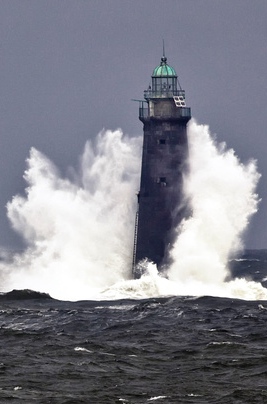
If you love lighthouses and want to learn about these guiding lights and navigational aids all over the world, then
The Lighthouse Directory is the website for you. It provides an astounding amount of information, linking to more than 17,200 of the world's lighthouses. Russ Rowlett, Adjunct Professor of Mathematics at the University of North Carolina at Chapel Hill, compiled the directory with the assistance of hundreds of lighthouse fans around the world who have enriched this site with their own information and suggestions. For a long time, Rowlett tried to maintain a list of lighthouses from his many friends and contacts, but it had grown too long (and too out of date) to display on the comprehensive site. Rowlett offers special thanks to
Michel Forand for his suggestions and editing, touching essentially every page of the directory, and Jeremy D'Entremont, Ted Sarah and Klaus Huelse, each contributing in vital ways.
The Maine
Lighthouse Museum
Another unique educational resource for U.S. Lighthouse history, Lifesaving and Lightship Services is the Maine Lighthouse Museum (MLM), located in Rockland, Maine, the heart of the Midcoast. Last October, the U.S. Lightship Museum presented a PowerPoint presentation at the MLM about U.S. lightships and
Nantucket/LV-112.
The mission of the Maine Lighthouse Museum is to educate the public regarding the longstanding traditions, heroism and progress of America's Lighthouse and Lifesaving Services and the U.S. Coast Guard through the conservation and interpretation of the nation's most significant collection of lighthouse and lifesaving artifacts. From sparkling lenses to heartwarming stories of the keepers and their families, the Maine Lighthouse Museum is truly America's lighthouse museum. For more information, log on to the
Maine Lighthouse Museum or call 207.594.3301.
American Express
Amex Industrial Services, Inc.
Association of Public Safety Communications Officials - Atlantic Chapter
BAE Systems
Bluefin Robotics
Boston Forge & Welding Corp.
Boston Harbor
Shipyard & Marina
The Boston Foundation
ThreeBees Fund
Burnham Associates, Inc.
Burnham Marine
California Public Safety Radio Association
Cameron International Corporation
Charitable Adult Rides and Services, Inc. C/J Towing & Recovery Claflin & Son Nautical Antiques Crandall Dry Dock Engineers
Capt. Robertson P. Dinsmore Fund
Donahue, Tucker & Ciandella, PLLC
East Boston Foundation
Eastern Bank Charitable
Foundation
Egan Maritime Institute,
Nantucket Shipwreck &
Lifesaving Museum
Fitzgerald Shipyard
Foss Maritime
Friends of the
Boston Harbor Islands
H&H Propeller, Inc.
J. Hewitt Marine
Electrical Services
Kelly Automotive Group
H.F. Lenfest Fund
The Lightship Group, LLC
McAllister Towing &
Transportation Co.
Joe and Pepette Mongrain
Fund
National Trust for
Historic Preservation
New England
Lighthouse Lovers
New London Maritime Society and Custom House Maritime Museum The Sail Loft, LLC, Nantucket Sherwin-Williams
Industrial Marine Coatings Division
T & M Services
Town of Oyster Bay,
Long Island, NY
U.S. Coast Guard Lightship Sailors Association
West Marine
U.S. Lighthouse Society
USLM Members
Verizon Foundation
Zuni Maritime Foundation USS Zuni / USCG Tamaroa
Individual Donors


USLM is a member
of the following organizations 
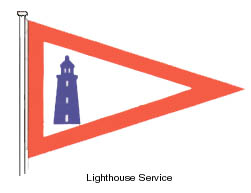
The flag of the United States Lighthouse Service
Teach children about lightships with the book
Lightship
Editorial From School
Library Journal
Kindergarten-Grade 2: Lightships were anchored where lighthouses could not be built. They protected our ocean harbors as well as points along the Great Lakes. The last one (
Nantucket/LV-613
) was decommissioned in 1983, so this fascinating picture book is a piece of nautical history. Brian Floca's watercolor drawings depict daily life aboard one of these vessels, cooking, sleeping, working, all the while rolling with the rhythm of the waves. Many hazards were involved. Big ships came too close, anchors lost their mooring, and weather caused many problems. But when the fog rolled in, the lightship sprang into action. Lights flashed and horns sounded, allowing ship traffic to make it "through fog and night, past rocks and shoals, past reefs and wrecks, past danger." The drawings are very detailed. Some pages are collages of small scenes. Many are full spreads. The sailors' facial expressions are amusing to watch, and the resident cat appears on almost every page. The front and back endpapers show a cutaway view of one of the vessels. This fascinating, little-known slice of history should prove interesting to every child who loves big boats.
-- Ieva Bates, Ann Arbor District Library, MI
(review originally published by Reed Business Information, Inc.)
The book
Lightship
, by Brian Floca, can be purchased on
Amazon.com
. For more information about lightships, click on Brian Floca's
blog
.
 |
|
For more information about the U.S. Coast Guard Lightship Sailors Association and the U.S. Lightship Service, click on logo
|
Lead, Kindly Light
By John Henry Newman
(1801-1890)
"Lead, Kindly Light, amidst th'encircling gloom,
Lead Thou me on!
The night is dark, and I am far from home,
Lead Thou me on!
Keep Thou my feet; I do not ask to see
The distant scene; one step enough for me.
I was not ever thus, nor prayed that Thou
Shouldst lead me on;
I loved to choose and see my path; but now
Lead Thou me on!
I loved the garish day, and, spite of fears,
Pride ruled my will. Remember not past years!
So long Thy power hath blest me, sure it still
Will lead me on.
O'er moor and fen, o'er crag and torrent, till
The night is gone,
And with the morn those angel faces smile,
Which I have loved long since, and lost awhile!
Meantime, along the narrow rugged path,
Thyself hast trod,
Lead, Saviour, lead me home in childlike faith,
Home to my God.
To rest forever after earthly strife
In the calm light of everlasting life."
Note: "Lead Kindly Light" was a poem originally written by John Henry Newman (1801-1890), who was 33 years old when he found himself on a boat from the Sicilian city of Palermo to Marseille, France. Newman, who was recovering after being dangerously ill with a fever, was on the boat to return to his native England when he penned the lyrics to "Lead, Kindly Light." The context that Newman was recovering from a frightening illness in the middle of the sea gives insight to the lyrics.
Photo above: Pigeon Point Lighthouse in California, by Darvin Atkeson
Poem posted on
LV-112 while in service on Nantucket Shoals Lightship Station
"When a sailor gets to thinking
He is one of the best
Let him ship out on a lightship
And take the acid test.
And if he feels like bragging
I don't think that all of his tales
Will be of deep sea sailing
But of the ship that never
Poem provided by Peter Brunk,
USCG-Ret., Commanding Officer,
Nantucket/LV-112, 1970-71, who serves on the USLM Board of Directors
|
This comprehensive New England shipwreck website is a helpful resource for SCUBA divers, maritime history researchers and enthusiasts. The site includes many photographs, charts, reference documents and history about many shipwrecks located in New England waters. For more information,
The Sinking of the U-853
by Capt. William Palmer
When the German enemy submarine
U-853 entered U.S. waters off Portland, Maine in 1945, it torpedoed and sank the
USS Eagle-56.
Nantucket/LV-112, converted to an examination vessel,
USS Nantucket (1942-45) during WWII, helped save the crew of the
USS Eagle-56.
This is a book about the
U-853
story, researched and written by
Capt. Bill Palmer
, a long-time shipwreck researcher, diver and preservationist.
Description of book: "Out in the cold Atlantic Ocean off the coast of Rhode Island, lies the remains of what was once a feared and mighty hunter. It's not a fish or shark, for that matter it is not even a marine creature. It's what men feared the most when they went to sea aboard their vessel back during the World War II years. It's a German submarine called a U-Boat. The
U-853 was the last German submarine sunk in World War II. She was sunk with all hands just minutes before World War II ended. The once mighty hunter feared by all who put to sea, now lies in 130 feet of water off the coast of Block Island, Rhode Island, her grave marked only by a circle on the nautical charts, DANGER Unexploded Depth Charges, May 1945."
Capt. Palmer has been running a charter boat for wreck-diving, shark-fishing and shark-cage-diving off the coast of Rhode Island and Connecticut for 40 years.
German U-boat attack off Portland, Maine, during WWII, involving
LV-112 (USS Nantucket)
This book is the story of a small U.S. sub-chaser, the
Eagle 56, caught in the crosshairs of a German U-boat, the
U-853, whose brazen commander doomed his own crew in a desperate, last-ditch attempt to record final kills before his country's imminent defeat a few weeks later in May. And it is the account of how one man, Paul M. Lawton, embarked on an unrelenting quest for the truth and changed naval history.
For more information, log onto: "
Due to Enemy Action
"
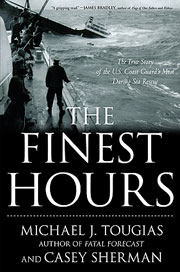
"In February of 1952, one of the worst storms to ever hit the East Coast struck New England, damaging an oil tanker off the coast of Cape Cod and literally ripping it in half. On a small lifeboat faced with frigid temperatures and 70-foot high waves, four members of the U.S. Coast Guard (Bernie Webber and three other crewmen) set out to rescue the more than 30 stranded sailors trapped aboard the rapidly sinking vessel. 'The Finest Hours' is the story of their heroic mission, which is still considered the greatest small boat rescue in Coast Guard history."
(Michelle McCue, 9/9/14)
Bernie Webber (later served on
Nantucket/LV-112, 1958-60) and the three other crewmen were awarded the coveted USCG Gold Lifesaving Medal for their heroism in what is considered by maritime historians to be "the greatest small boat rescue in Coast Guard history." Mr. Webber, who was a member of the USCG Lightship Sailors Association, was extremely helpful in assisting the
USLM-Nantucket/LV-112 compile research information and historic documents about
LV-112. He was a pleasure and honor to work with. Bernie passed away in January 2009. He was considered "A Real American Hero" and is dearly missed.
To learn more about
lighthouse news, click on
Lighthouse Digest

Explore the oceans in depth and Woods Hole Oceanographic Institution with
Oceanus magazine
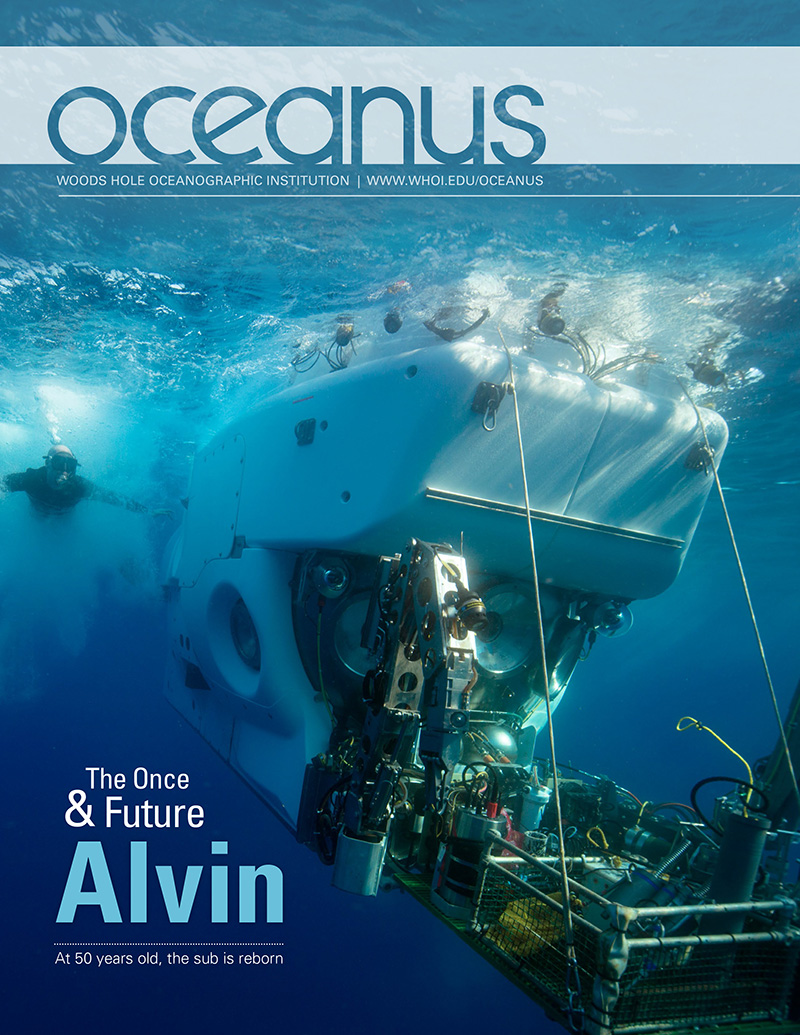
Oceanus
explores the oceans in depth, highlighting the research and researchers at Woods Hole Oceanographic Institution in news, features and interviews written by magazine staff, with full-color photographs and illustrations. Each issue covers a wide spectrum of oceanography, spanning coastal research, marine life, deep-ocean exploration and the ocean's role in climate, as well as ocean technology and policy. To learn more, click on magazine cover above.
Lightships, Lighthouses & Lifeboat Stations:
A Memoir and History
Lightships, Lighthouses & Lifeboat Stations is part history book, part memoir, written by Bernie Webber, recipient of the Coast Guard's highest award, the Gold Life-saving Medal, and hero of the Disney movie The Finest Hours. While the public will recognize Webber's name from the movie and the bestselling book by the same name, few people know that during his lengthy Coast Guard career he served on lightships (ships anchored in dangerous areas to warn other vessels of hazards) in addition to lifeboat stations (small boat rescue stations) and lighthouses. Webber poses the following question: "How did the lightship men cope with the isolation, constant loneliness, boredom, fear, or just sheer terror? All were part of life on board a lightship. Rough seas tossed the ship about, rearing up and down on the anchor chain. This was a world of isolation, noise from operating machinery, and blasts from the powerful foghorn that went on for hours, sometimes days, at a time." Webber answers that question in this book, drawing on a combination of personal experience and meticulous historical research. Discussions of men going mad, lightships being run down by larger ships, anchor chains breaking, and lightships cast upon shoals are offset by humorous stories and the author's reflections on his best days at sea. Fourteen historic photos are included, as well as a foreword by Michael Tougias.(reprinted from Amazon).
Help support the restoration of LV-112 by donating your old car and receive a tax deduction
How it works
We have teamed with Charitable Auto Resources, Inc. (CARS), to accept vehicle donations across the United States. Once
you contact our customer service representative about making a donation, everything will be taken care of, including a receipt for your tax records. Sale proceeds will be donated to the USLM in your name. Donating your vehicle to the U.S. Lightship Museum is as easy as calling our representative toll-free at 855-500-7433.
For more information,
click here
.
The Lightships
of Cape Cod

Authored by Frederic L. Thompson, 1996, 2nd printing, 112 pages, soft wrap. Signed by the author. Illustrated with over 93 beautifully detailed photographs. Much sought-after, this scarce volume chronicles the history of the lightships in this vital area. Wonderfully detailed black-and-white photographs enhance the author's vivid description of the history and life aboard these vessels. One of the only volumes ever written exclusively on this subject, this fine work will make a fine addition to any library. Price: $14.95 plus shipping ($5.95), total: $20.90. May be purchased online
from the USLM; just click on "Donate" button in this newsletter and add a notation in the area provided. Or mail a check or money order addressed to: U.S. Lightship Museum, PO Box 454, Amesbury, MA 10913
U.S. Lightship Museums
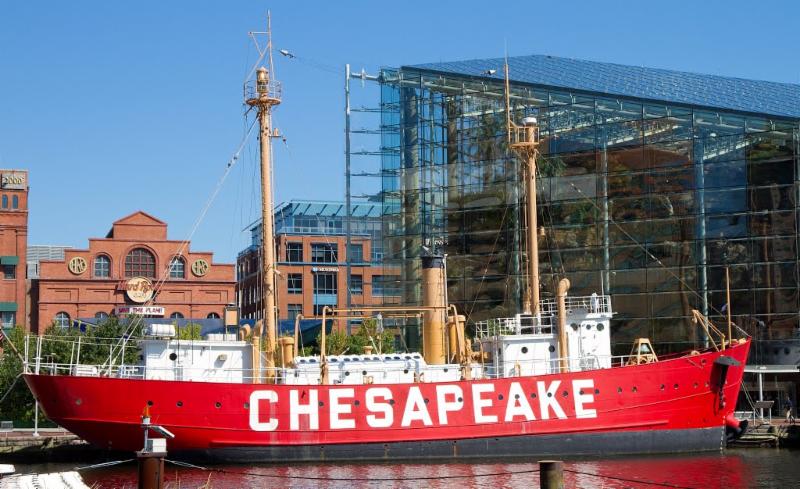
Relief/WLV-605
|
|
|
A crew member rings the bell on the foredeck of Nantucket New South Shoal No. 1 during low-visibility storm conditions. The i
llustration is from "Life on the South Shoal Lightship" by Gustov Kobbe,
Century Magazine, August 1891
Kenrick A. Claflin & Son Nautical Antiques
Click on the website link above to see nautical artifacts available at Kenrick A. Claflin & Son Nautical Antiques, which has donated publications to the USLM.
|
|
|
| |
|
Nantucket/LV-112 and the
perils of hurricane season
|
|
|
Nantucket/LV-112 on Nantucket Shoals Lightship Station during hurricane conditions in high seas, c. 1938.
|
Hurricane season (June 1 to November 30) is upon us and has wreaked havoc in the southern portion of the U.S. and Carribean. Our prayers and thoughts are with those who have been negatively impacted and suffered devastation. So far this year, those of us in the northeastern U.S. have luckily escaped the horrors of these catastrophic storms.
 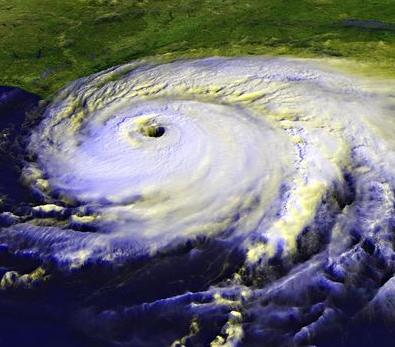
However, since the establishment of the United States Lightship Service, lightships were caught in the teeth of hurricanes and tropical storms. In fact, lightships and their crews were required to remain on station, regardless of the severe weather conditions. Hurricanes were no exception, including winter, which brings about a myriad of different issues and horrific storm conditions, including sub-zero weather patterns.
During Hurricane Edna, the force of 110 mph winds, coupled with 70-foot seas crashing into LV-112, broke through the pilot house portholes, tore off the ship's wheel (left) and destroyed the entire helm station on the flying bridge.
 |
|
 |
As a result of Edna's wrath, LV-112 USCG
crew member Dick
Arnold stands next to LV-112's damaged
flying bridge binnacle (lying on deck) with battered and smashed search lights, engine
order telegraph, etc.
|
In 1954, Edna's 110 mph winds
and
towering seas reaching 70 feet, relentlessly pounding LV-112's double-plated steel hull, buckling the ships bow plates. It broke the anchor chain, smashed through the nearly 1-inch-thick reinforced pilot house portholes, extinguished the ship's boilers, rendering her without power, and damaged the rudder, disabling the ship's ability to steer. In the nearly 40 years the historic lightship was in the USLHS and U.S. Coast Guard (USCG) service, it was the closest LV-112 ever came to sinking. LV-112 was originally built to be virtually unsinkable.
|
|
 |
|
LV-112 berthed at USCG Base Boston, upon being towed back from Nantucket Shoals station after battling Hurricane Edna. Notice the loss of the main anchor and damaged hull shell plating from being pounded by the heavy seas caused by Edna on the upper port forward quarter.
|
 |
|
|
 |
|
Dick Arnold holds broken die-lock anchor chain that parted from LV-112's 7,500-pound mushroom anchor.
|
 |
The famous ship's crew feared that the loss of their lives was inevitable as LV-112 was relentlessly pounded and tossed
like a toy boat by Hurricane Edna
. Former LV-112 crew members who were on board during the hurricane reported the lightship repeatedly listed upwards of 65 degrees from the force of the waves, nearly capsizing the largest U.S. floating lighthouse ever built. Click here to view 1954 newspaper reports. Prior to Edna, Nantucket/LV-112, had just endured Hurricane Carol, with comparable voracity, only 11 days before Edna struck.
 |
|
 |
Typical lightship mushroom anchor, weighing 6,500 to 7,500 pounds with section of chain. Photo taken at Overfalls Lightship Museum, located in Lewes, Delaware.
|
Since the creation of Nantucket
Shoals Lightship Station in 1854, the 11 lightships assigned and anchored there through
1983
have endured 34 hurricanes and tropical storms in addition to the many other winter storms and Nor'easters' that occurred yearly, a remarkable testament to the men and ships who served during the 129 years the station was in existence.
Of the 34 hurricanes and tropical storms that ravaged the lightships on Nantucket Shoals station, Nantucket/LV-112 withstood 14 of them during the 39 years it was assigned to Nantucket Shoals station and Portland, Maine, harbor during WWII. In fact, during a storm in 1878, Nantucket/LV-1's anchor chain parted and the 103-foot wood lightship drifted a distance of approximately 650 miles and ended up off the Bermuda coast. Keep in mind that the lightships stationed on Nantucket Shoals station were extremely isolated, anchored in nearly 200 feet of water and 100 miles from the U.S. mainland. It was the most treacherous and remote lightship station in the world, out of sight of land.
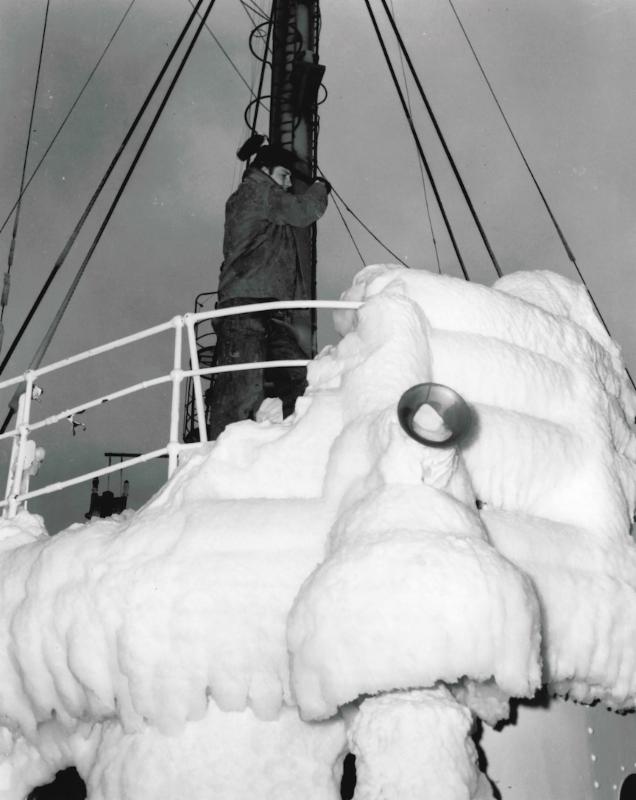
|
|
|
LV-112 is encased in heavy thick ice formed from sea spray in sub-freezing weather while on station, causing the ship to become top-heavy and more prone to capsizing in high seas. A USCG crew member chips away at the clearing dangerous ice from LV-112's superstructure while in port for servicing, January 1964. Photo courtesy of the U.S. Lighthouse Society
|
Of the 14 hurricanes and tropical storms that hit Nantucket/LV-112, five were the deadliest to ravage New England's coastal waters and Nantucket Shoals Lightship Station since 1635. During the Great Atlantic Hurricane of 1944, two U.S. Navy ships and three USCG vessels sank with the loss of many lives. One of the vessels, Vineyard Lightship, sank with the loss of all 12 crew members aboard in Vineyard Sound, three miles west of Cuttyhunk Island in Massachusetts.
|
|
|
Vineyard Lightship/LV-73, which served from 1901 to 1944, guided mariners away from the dangerous Sow and Pigs Reef at the western end of Cuttyhunk Island, Mass.
|
|
|
Memorial service held on
LV-112 for a Hurricane Edna survivor, Jim Sheahan
|
|
 |
|
James Sheahan, U.S. Coast Guard - 1954
|
 |
On August 7, National Lighthouse Day, the USLM held a memorial service on board LV-112 for James E. Sheahan, our friend, committed supporter and former U.S. Coast Guard Nantucket/LV-112 crew member (1954-56). Coincidently, Jim's birthday was on National Lighthouse Day. He attended the USLM's first two National Lighthouse Day celebrations. Jim lived in South Yarmouth, Mass. He passed away on June 14, 2017. Many members of Jim's family attended the service with several former LV-112 USCG crew members.
As an electronic technician in the USCG, Jim served on Nantucket/LV-112 as a radioman when Hurricane Edna struck the New England coast on September 11, 1954. During the hurricane, Jim Sheahan was burned when the radio equipment caught fire while he was attempting to send an SOS message. Jim managed to relay the following distress signal: "Taking water over the bow...smashing all ports...pilot house out of commission...steering gear out... we're taking hell of a beating out here."
|
|
|
Jim Sheahan on LV-112's foredeck, kneeling down next to the capstan performing maintenance with crewmates, 1954. During that period of time, the auxiliary mushroom anchor was secured on the starboard forward quarter on the foredeck, which required use of the deck crane, shown in photo. Imagine trying to release the 6,500-pound auxiliary mushroom anchor during the height of hurricane Edna, fighting 70-foot seas washing over the decks, and trying to lower the anchor in a challenging effort to prevent it from crashing into the ship's exterior shell plating and puncturing the hull.
|
|
|
|
The Sheahan Family on LV-112, with Audrey, Jim's wife for 58 years, at center. Memorial service photos by Ron Janard
|
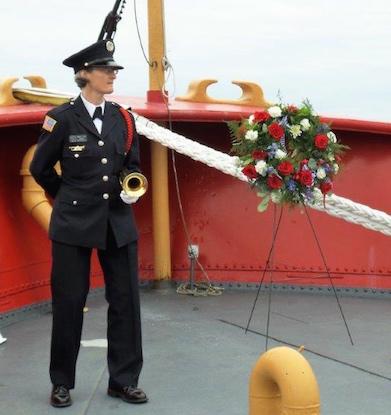
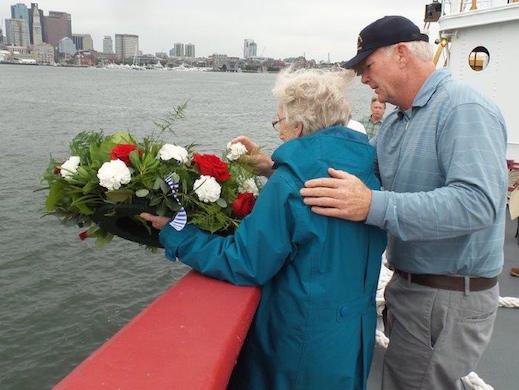 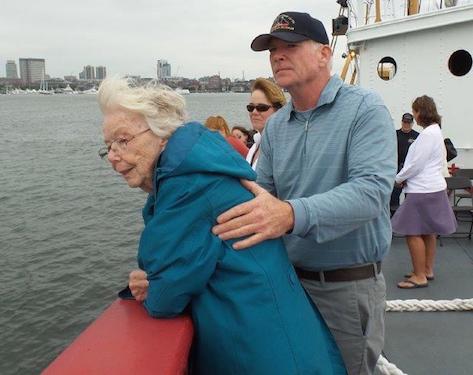
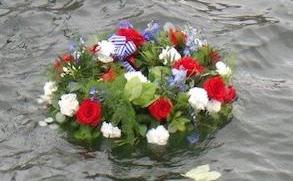
|
|
Nantucket Lightship/LV-112
visitor highlights
|
|
|
Members of The Harbor Keepers, a nonprofit organization based in East Boston, visited LV-112 to explore the historic lightship and learn local maritime history. While a commissioned USCG lightship, LV-112 also served as an oceanographic, environmental research and reporting ship in conjunction with Woods Hole Oceanographic Institution. The Harborkeepers group offers coastal and marine education that creates opportunities for the community to learn about weather, climate and our ecosystem. They also coordinate local shoreline clean-ups with volunteers, removing discarded debris from the Harborwalk and other East Boston waterfront areas.
|
A couple from Long Island, New York, came up to visit LV-112 with their 8-year-old daughter, Alexi, a
lighthouse aficionado. She had never been to a lightship and wanted to explore LV-112. Alexi was
very knowledgeable
about
lighthouses and inspired by their
 history. She had visited
30 different lighthouses as far away as Key
West, Florida. It was refreshing to meet such a young person who was interested and motivated by history. Our nation needs more youths like Alexi, the historic preservationists of tomorrow.
history. She had visited
30 different lighthouses as far away as Key
West, Florida. It was refreshing to meet such a young person who was interested and motivated by history. Our nation needs more youths like Alexi, the historic preservationists of tomorrow.
Alexi, next to LV-112's
massive anchor chain in the
anchor windlass room.
|
|
|
Former USCG LV-112 crewmember Peter Bombard, who served as cook on LV-112 from 1973-75 and also served on Nantucket/LV-612 for four months until his discharge from the USCG. LV-612 replaced LV-112 upon its decommissioning in 1975. Peter's service in the USCG was from 1971-75, after which he became a professional baker.
|
|
|
|
Emily and Joan (right), Boston-area residents, on board LV-112 for a tour. Joan, originally from Great Britain, was a passenger on the SS United States. She was a nanny to an American diplomat family in Hungary, where the father was the U.S. ambassador. When he unexpectedly died, Joan traveled back with the mother and their children on the SS United States to New York Harbor and eventually moved to Boston. Nantucket/LV-112 guided the SS United States for virtually the famous ocean liner's entire career (1952-69), to and from the U.S. and Europe.
|
|
|
LV-112 visitors wave to one of the many daily Boston Harbor tour vessels that offer their passengers a narrated history lesson about Nantucket Lightship/LV-112.
|
|
|
What do the USNS Comfort and Nantucket/LV-112 have in common?
|
|
|
USNS Comfort (T-AH-20) in dry-dock, South Boston, where earlier this year, Boston Ship Repair had the overhaul contract. The Lightship Group, LLC, is a subcontractor for Boston Ship Repair and a U.S. Lightship Museum, Nantucket/LV-112 restoration contractor, in addition to Fitzgerald Shipyard
and Gloucester Marine Railways (special projects). The
Lightship Group, LLC (name is coincidental) is a U.S. Navy,
U.S. Coast Guard, NOAA and Merchant Marine contractor.
Photo by Peter Starr
Both the Comfort and LV-112 were created to save lives.
The Mercy-class Military Sealift Command hospital ship USNS Comfort (T-AH-20) was recently deployed to Puerto Rico to assist in humanitarian relief efforts. Comfort's primary mission
is to provide an afloat, mobile and acute surgical medical
facility to the U.S. military that is flexible, capable, and uniquely adaptable to support expeditionary warfare. Comfort's secondary mission is to provide full hospital services to support U.S. disaster relief and humanitarian operations worldwide. With its 1,000-bed capacity, USNS Comfort and its sister ship, the Mercy, are the largest hospital ships in the world. The twin ships actually are former oil tankers converted into floating hospitals, each the height of a 10-story building and the length of three football fields.
|
|
Recollections of a former whaling harpooner and 1867 Nantucket/LV-1 crewmember for 22 years
 |
|
 |
Andrew Jackson Sandsbury
Photo: Nantucket Historical Assoc.
|
Andrew Jackson
Sandsbury (1830-1902), former whaling ship crewmember who also served on Nantucket New South Shoals No1 Lightship for 22 years, also as captain, was remembered by his great-granddaughter, Frances Eckhardt, who tells the story of her great-grandfather's unique adventures as a mariner.
Virginia Turner Sandsbury Friberg,
the great-great-granddaughter of Andrew J. Sandsbury, furnished the information about her family that is part of an exhibit at the Nantucket Lightship Basket Museum on Nantucket Island.
Captain Sandsbury was on board Nantucket LV-1 in 1878 when the lightship's anchor chain broke and was blown off station, ending up off the shores of Bermuda. Since Captain Sandbury was a well-respected basket maker (famed Nantucket Lightship baskets), the material for this article originated and is on exhibit at the Nantucket Lightship Basket Museum on Nantucket Island. To read the full article about Captain Sandsbury, click here.
|
|
LV-1 on Nantucket Shoals Lightship Station, c. 1856. During
that time period, the historic lightship was referred to as Nantucket New South Shoal No1. LV-1 was heavily built of white and live oak. It served on Nantucket Shoals station for 37 years and finally was decommissioned from lightship service in 1930, after serving on four other East Coast lightship stations, as far south as Savannah, Georgia. All total, it was a U.S. light beacon for 74 years!
|
|
1967 LV-112 crew snapshots on Nantucket Shoals Lightship Station
|
|
 |
LV-112 crew member next to LV-112's main light beacon atop the 70-foot main mast, doing maintenance. Photos by John Davenport, another member of the crew
|
 |
|
|
 |
|
LV-112 lightship sailors off-duty, relaxing in the crew's quarters. Being so far from the mainland, television reception was intermittent while anchored on station. However, movies, music and a good game of cards helped pass the time during calm seas, when the weather cooperated.
|
 |
|
|
Movie time in
LV-112's crew's quarters. USCG lightships were supplied with 16mm versions of full-length films, such as "The Graduate," The Dirty Dozen" and "Cool Hand Luke," popular 1967 movies shown in theaters on the mainland.
|
|
Help support Nantucket/LV-112's restoration when you shop on Amazon with AmazonSmile
AmazonSmile is a simple and automatic way for you to support the efforts of the U.S. Lightship Museum and
Nantucket Lightship/LV-112 every time you shop, at no cost to you. When you shop at
smile.amazon.com, you'll find the exact same low prices, vast selection and convenient shopping experience as Amazon.com, with the added bonus that Amazon will donate a portion of the purchase price to the U.S. Lightship Museum, among nearly 1 million organizations from which to choose. The U.S. Lightship Museum is a registered and approved AmazonSmile charity. For more information on how to participate
click here
.
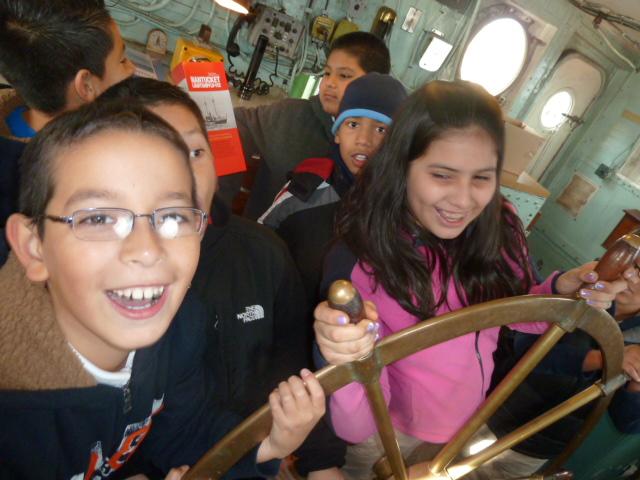
|
Become a USLM member today
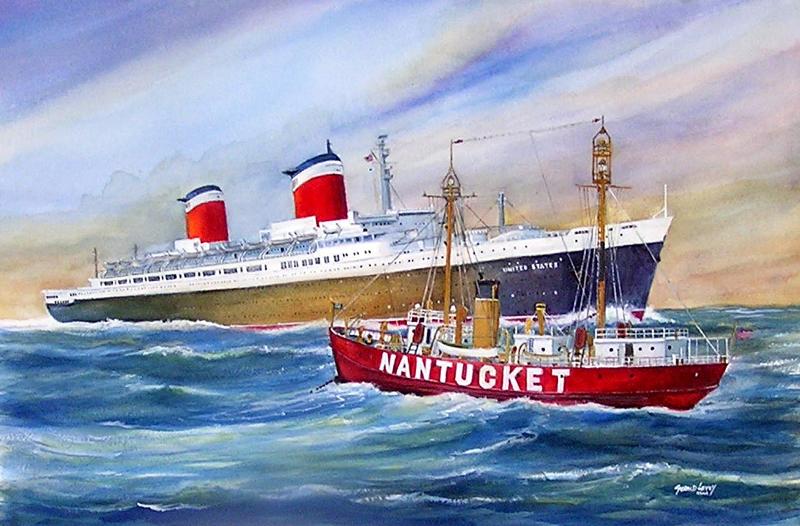 |
|
For a gift of $1,000 or more, donors will receive a limited-edition, fine-art print of the SS United States passing Nantucket/LV-112, signed by marine artist Gerald Levey
|
When you become a member of the U.S. Lightship Museum (USLM), you will be helping rescue and preserve Nantucket Lightship/LV-112, a National Historic Landmark and National Treasure that is an important part of our nation's maritime heritage. Plus you will have the satisfaction of knowing you are a contributing partner in the legacy of the world's most famous and largest U.S. lightship ever built. The USLM is a member of the Council of Maritime Museums (CAMM) and the Historic Naval Ships Association (HNSA). All USLM members will be granted reciprocal privileges (free admission) at participating CAMM institutions. For more information about the benefits and the USLM Membership program, click on USLM Membership.

All electronic donations will be processed by PayPal.
We thank everyone for their ongoing
contributions
and support
|
|
| |
| |
|
|